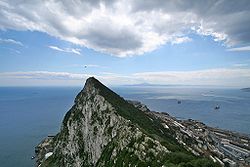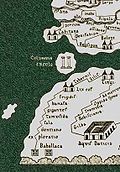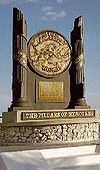
Pillars of Hercules
Encyclopedia

Classical antiquity
Classical antiquity is a broad term for a long period of cultural history centered on the Mediterranean Sea, comprising the interlocking civilizations of ancient Greece and ancient Rome, collectively known as the Greco-Roman world...
to the promontories
Promontory
Promontory may refer to:*Promontory, a prominent mass of land which overlooks lower lying land or a body of water*Promontory, Utah, the location where the United States first Transcontinental Railroad was completed...
that flank the entrance to the Strait of Gibraltar
Strait of Gibraltar
The Strait of Gibraltar is a narrow strait that connects the Atlantic Ocean to the Mediterranean Sea and separates Spain in Europe from Morocco in Africa. The name comes from Gibraltar, which in turn originates from the Arabic Jebel Tariq , albeit the Arab name for the Strait is Bab el-Zakat or...
. The northern Pillar is the Rock of Gibraltar
Rock of Gibraltar
The Rock of Gibraltar is a monolithic limestone promontory located in Gibraltar, off the southwestern tip of Europe on the Iberian Peninsula. It is high...
in the British overseas territory of Gibraltar
Gibraltar
Gibraltar is a British overseas territory located on the southern end of the Iberian Peninsula at the entrance of the Mediterranean. A peninsula with an area of , it has a northern border with Andalusia, Spain. The Rock of Gibraltar is the major landmark of the region...
. A corresponding North African peak not being predominant, the identity of the southern Pillar has been disputed through history, with the two most likely candidates being Monte Hacho
Monte Hacho
Monte Hacho is a low mountain that overlooks the Spanish city of Ceuta, on the north coast of Africa. Monte Hacho is positioned on the Mediterranean coast at the Strait of Gibraltar opposite Gibraltar, and along with the Rock of Gibraltar is claimed by some to be one of the Pillars of Hercules .In...
in Ceuta
Ceuta
Ceuta is an autonomous city of Spain and an exclave located on the north coast of North Africa surrounded by Morocco. Separated from the Iberian peninsula by the Strait of Gibraltar, Ceuta lies on the border of the Mediterranean Sea and the Atlantic Ocean. Ceuta along with the other Spanish...
and Jebel Musa in Morocco
Morocco
Morocco , officially the Kingdom of Morocco , is a country located in North Africa. It has a population of more than 32 million and an area of 710,850 km², and also primarily administers the disputed region of the Western Sahara...
.


Naming
According to Greek mythologyGreek mythology
Greek mythology is the body of myths and legends belonging to the ancient Greeks, concerning their gods and heroes, the nature of the world, and the origins and significance of their own cult and ritual practices. They were a part of religion in ancient Greece...
adopted by the Etruscans and Romans, when Hercules
Hercules
Hercules is the Roman name for Greek demigod Heracles, son of Zeus , and the mortal Alcmene...
had to perform twelve labours, one of them was to fetch the Cattle of Geryon
Geryon
In Greek mythology, Geryon , son of Chrysaor and Callirrhoe and grandson of Medusa, was a fearsome giant who dwelt on the island Erytheia of the mythic Hesperides in the far west of the Mediterranean. A more literal-minded later generation of Greeks associated the region with Tartessos in southern...
of the far West and bring them to Eurystheus
Eurystheus
In Greek mythology, Eurystheus was king of Tiryns, one of three Mycenaean strongholds in the Argolid, although other authors including Homer and Euripides cast him as ruler of Argos: Sthenelus was his father and the "victorious horsewoman" Nicippe his mother, and he was a grandson of the hero...
; this marked the westward extent of his travels. A lost passage of Pindar
Pindar
Pindar , was an Ancient Greek lyric poet. Of the canonical nine lyric poets of ancient Greece, his work is the best preserved. Quintilian described him as "by far the greatest of the nine lyric poets, in virtue of his inspired magnificence, the beauty of his thoughts and figures, the rich...
quoted by Strabo
Strabo
Strabo, also written Strabon was a Greek historian, geographer and philosopher.-Life:Strabo was born to an affluent family from Amaseia in Pontus , a city which he said was situated the approximate equivalent of 75 km from the Black Sea...
was the earliest traceable reference in this context: "the pillars which Pindar calls the 'gates of Gades' when he asserts that they are the farthermost limits reached by Heracles."
According to Plato
Plato
Plato , was a Classical Greek philosopher, mathematician, student of Socrates, writer of philosophical dialogues, and founder of the Academy in Athens, the first institution of higher learning in the Western world. Along with his mentor, Socrates, and his student, Aristotle, Plato helped to lay the...
's account, the lost realm of Atlantis
Atlantis
Atlantis is a legendary island first mentioned in Plato's dialogues Timaeus and Critias, written about 360 BC....
was situated beyond the Pillars of Hercules, in effect placing it in the realm of the Unknown. Renaissance tradition says the pillars bore the warning Nec plus ultra (also Non plus ultra, "nothing further beyond"), serving as a warning to sailors and navigators to go no further.
According to some Roman sources, while on his way to the island of Erytheia Hercules had to cross the mountain that was once Atlas
Atlas
An atlas is a collection of maps; it is typically a map of Earth or a region of Earth, but there are atlases of the other planets in the Solar System. Atlases have traditionally been bound into book form, but today many atlases are in multimedia formats...
. Instead of climbing the great mountain, Hercules used his superhuman strength to smash through it. By doing so, he connected the Atlantic Ocean
Atlantic Ocean
The Atlantic Ocean is the second-largest of the world's oceanic divisions. With a total area of about , it covers approximately 20% of the Earth's surface and about 26% of its water surface area...
to the Mediterranean Sea
Mediterranean Sea
The Mediterranean Sea is a sea connected to the Atlantic Ocean surrounded by the Mediterranean region and almost completely enclosed by land: on the north by Anatolia and Europe, on the south by North Africa, and on the east by the Levant...
and formed the Strait of Gibraltar
Strait of Gibraltar
The Strait of Gibraltar is a narrow strait that connects the Atlantic Ocean to the Mediterranean Sea and separates Spain in Europe from Morocco in Africa. The name comes from Gibraltar, which in turn originates from the Arabic Jebel Tariq , albeit the Arab name for the Strait is Bab el-Zakat or...
. One part of the split mountain is Gibraltar
Gibraltar
Gibraltar is a British overseas territory located on the southern end of the Iberian Peninsula at the entrance of the Mediterranean. A peninsula with an area of , it has a northern border with Andalusia, Spain. The Rock of Gibraltar is the major landmark of the region...
and the other is either Monte Hacho
Monte Hacho
Monte Hacho is a low mountain that overlooks the Spanish city of Ceuta, on the north coast of Africa. Monte Hacho is positioned on the Mediterranean coast at the Strait of Gibraltar opposite Gibraltar, and along with the Rock of Gibraltar is claimed by some to be one of the Pillars of Hercules .In...
or Jebel Musa
Jebel Musa, Morocco
Jebel Musa , Mount Moses in English, is the name given to a mountain located in the northernmost part of Morocco on the African side of the Straits of Gibraltar...
. These two mountains taken together have since then been known as the Pillars of Hercules, though other natural features have been associated with the name. Diodorus Siculus
Diodorus Siculus
Diodorus Siculus was a Greek historian who flourished between 60 and 30 BC. According to Diodorus' own work, he was born at Agyrium in Sicily . With one exception, antiquity affords no further information about Diodorus' life and doings beyond what is to be found in his own work, Bibliotheca...
, however, held that instead of smashing through an isthmus to create the Straits of Gibraltar, Hercules instead narrowed an already existing strait to prevent monsters from the Atlantic Ocean from entering the Mediterranean Sea.
Pillars as portals
The Pillars appear as supporters of the coat of arms of SpainSpain
Spain , officially the Kingdom of Spain languages]] under the European Charter for Regional or Minority Languages. In each of these, Spain's official name is as follows:;;;;;;), is a country and member state of the European Union located in southwestern Europe on the Iberian Peninsula...
, originating from the famous impresa of the Holy Roman Emperor, Charles V, who was King of Spain in the years following the discovery of the Americas. It bears the motto Plus Ultra
Plus Ultra (motto)
Plus ultra is the national motto of Spain adopted from the personal motto of Charles I of Spain. Earl Rosenthal, author of The Palace of Charles V in Granada , has researched the origin of the motto...
(Latin
Latin
Latin is an Italic language originally spoken in Latium and Ancient Rome. It, along with most European languages, is a descendant of the ancient Proto-Indo-European language. Although it is considered a dead language, a number of scholars and members of the Christian clergy speak it fluently, and...
for further beyond), encouraging him to ignore the ancient warning, to take risks and go further beyond. It indicates the desire to see the Pillars as an entrance to the rest of the world rather than as a gate to the Mediterranean Sea
Mediterranean Sea
The Mediterranean Sea is a sea connected to the Atlantic Ocean surrounded by the Mediterranean region and almost completely enclosed by land: on the north by Anatolia and Europe, on the south by North Africa, and on the east by the Levant...
. It also indicates the overseas possessions that Spain had.
One of the commonly held theories about the origin of the Dollar Sign
Dollar sign
The dollar or peso sign is a symbol primarily used to indicate the various peso and dollar units of currency around the world.- Origin :...
derives it from the above personal device, which appeared on the Spanish Dollar
Spanish dollar
The Spanish dollar is a silver coin, of approximately 38 mm diameter, worth eight reales, that was minted in the Spanish Empire after a Spanish currency reform in 1497. Its purpose was to correspond to the German thaler...
from which the American one was derived - thus, the two vertical lines on the Dollar Sign ultimately represent the Pillars of Hercules.
Phoenician connection
Beyond Gades, several important Mauritanian colonies (in modern-day MoroccoMorocco
Morocco , officially the Kingdom of Morocco , is a country located in North Africa. It has a population of more than 32 million and an area of 710,850 km², and also primarily administers the disputed region of the Western Sahara...
) were founded by the Phoenicia
Phoenicia
Phoenicia , was an ancient civilization in Canaan which covered most of the western, coastal part of the Fertile Crescent. Several major Phoenician cities were built on the coastline of the Mediterranean. It was an enterprising maritime trading culture that spread across the Mediterranean from 1550...
ns as the Phoenician merchant navy pushed through the Pillars of Hercules and began constructing a series of bases along the Atlantic coast starting with Lixus
Lixus
Lixus refers to the following things:* lixus, the Latin word for "boiled"* Lixus in Morocco* Lixus , a genus of true weevils...
in the north, then Chellah
Chellah
Chellah, or Sala Colonia is a necropolis and complex of ancient Roman Mauretania Tingitana and medieval ruins at Rabat, Morocco. It is the most ancient human settlement on the mouth of the Bou Regreg River.-History:...
and finally Mogador.
Near the eastern shore of the island of Gades/Gadeira (modern Cádiz
Cádiz
Cadiz is a city and port in southwestern Spain. It is the capital of the homonymous province, one of eight which make up the autonomous community of Andalusia....
, just beyond the strait) Strabo
Strabo
Strabo, also written Strabon was a Greek historian, geographer and philosopher.-Life:Strabo was born to an affluent family from Amaseia in Pontus , a city which he said was situated the approximate equivalent of 75 km from the Black Sea...
describes the westernmost temple of Tyrian Heracles
Heracles
Heracles ,born Alcaeus or Alcides , was a divine hero in Greek mythology, the son of Zeus and Alcmene, foster son of Amphitryon and great-grandson of Perseus...
, the god with whom Greeks associated the Phoenician and Punic Melqart
Melqart
Melqart, properly Phoenician Milk-Qart "King of the City", less accurately Melkart, Melkarth or Melgart , Akkadian Milqartu, was tutelary god of the Phoenician city of Tyre as Eshmun protected Sidon. Melqart was often titled Ba‘l Ṣūr "Lord of Tyre", the ancestral king of the royal line...
, by interpretatio graeca
Interpretatio graeca
Interpretatio graeca is a Latin term for the common tendency of ancient Greek writers to equate foreign divinities to members of their own pantheon. Herodotus, for example, refers to the ancient Egyptian gods Amon, Osiris and Ptah as "Zeus", "Dionysus" and "Hephaestus", respectively.-Roman...
. Strabo
Strabo
Strabo, also written Strabon was a Greek historian, geographer and philosopher.-Life:Strabo was born to an affluent family from Amaseia in Pontus , a city which he said was situated the approximate equivalent of 75 km from the Black Sea...
notes that the two bronze pillars within the temple, each eight cubit
Cubit
The cubit is a traditional unit of length, based on the length of the forearm. Cubits of various lengths were employed in many parts of the world in Antiquity, in the Middle Ages and into Early Modern Times....
s high, were widely proclaimed to be the true Pillars of Hercules by many who had visited the place and had sacrificed to Heracles there. But Strabo believes the account to be fraudulent, in part noting that the inscriptions on those pillars mentioned nothing about Heracles, speaking only of the expenses incurred by the Phoenicians in their making. The columns of the Melqart temple at Tyre were also of religious significance.
Dantes' Inferno
In InfernoThe Divine Comedy
The Divine Comedy is an epic poem written by Dante Alighieri between 1308 and his death in 1321. It is widely considered the preeminent work of Italian literature, and is seen as one of the greatest works of world literature...
XXVI Dante Alighieri
Dante Alighieri
Durante degli Alighieri, mononymously referred to as Dante , was an Italian poet, prose writer, literary theorist, moral philosopher, and political thinker. He is best known for the monumental epic poem La commedia, later named La divina commedia ...
mentions Ulysses
Odysseus
Odysseus or Ulysses was a legendary Greek king of Ithaca and the hero of Homer's epic poem the Odyssey. Odysseus also plays a key role in Homer's Iliad and other works in the Epic Cycle....
in the pit of the Fraudulent Counsellors and his voyage past the Pillars of Hercules. Ulysses justifies endangering his sailors by the fact that his goal is to gain knowledge of the unknown. After five months of navigation in the ocean, Ulysses sights the mountain of Purgatory
Purgatory
Purgatory is the condition or process of purification or temporary punishment in which, it is believed, the souls of those who die in a state of grace are made ready for Heaven...
but encounters a whirlwind from it that sinks his ship and all on it for their daring
Hubris
Hubris , also hybris, means extreme haughtiness, pride or arrogance. Hubris often indicates a loss of contact with reality and an overestimation of one's own competence or capabilities, especially when the person exhibiting it is in a position of power....
to approach Purgatory while alive, by their strength and wits alone.

Sir Francis Bacon's Novum Organum
The Pillars appear prominently on the engraved title page of Sir Francis Bacon's Instauratio Magna ("Great Renewal"), 1620, the foreword to his Novum OrganumNovum Organum
The Novum Organum, full original title Novum Organum Scientiarum, is a philosophical work by Francis Bacon, written in Latin and published in 1620. The title translates as new instrument, i.e. new instrument of science. This is a reference to Aristotle's work Organon, which was his treatise on...
. The motto along the base says Multi pertransibunt et augebitur scientia ("Many will pass through and knowledge will be the greater").

